the netherlands
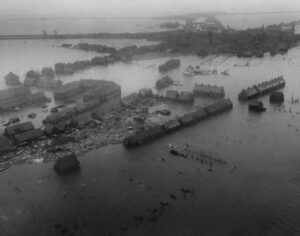
 The early warning systems we have in place these days could have easily saved many of the lives of the 2551 people who lost their lives on January 31, 1953, during the North Sea Flood. The flood caused catastrophic damage and loss of life in Scotland, England, Belgium and The Netherlands. It became one of the worst peacetime disasters of the 20th century. In the course of the flood, 307 people died in England, 19 died in Scotland, 28 died in Belgium, 1,836 died in the Netherlands, and an additional 361 people died at sea.
The early warning systems we have in place these days could have easily saved many of the lives of the 2551 people who lost their lives on January 31, 1953, during the North Sea Flood. The flood caused catastrophic damage and loss of life in Scotland, England, Belgium and The Netherlands. It became one of the worst peacetime disasters of the 20th century. In the course of the flood, 307 people died in England, 19 died in Scotland, 28 died in Belgium, 1,836 died in the Netherlands, and an additional 361 people died at sea.
The North Sea Flood of 1953 was an unusual storm, that was caused by a number of contributing elements, that combined together to make it more deadly and devastating than the average storm or even the average flood. The annual spring tides, a deep pressure system…something that in itself can cause the sea to rise, combined with severe gale force winds…recorded at 126 miles per hour at Costa Hill in Scotland and the result was the North Sea Flood of 1953. All of these elements funneled those high tides southward toward the narrow, and shallow…just 571 feet deep, English Channel, causing the swell to rise even further. The storm surge was recorded at 18.4 feet at its peak.
The tide came in slowly at first, and nobody was alarmed. The official weather forecast was a slight drizzle and strong winds but nothing regarding waves and tidal flow. Life went on as usual, the ships set sail and people went to work or to play. Yes, life went on as usual…until it didn’t. What began as a calm evening was quickly changed into a nightmare. The tide became unpredictable and surged over the sea walls at different points during the evening, taking many by surprise and leaving no time to warn others. One survivor in Norfolk said, that it took less than 15 minutes from the water first tricking into his home, to reaching almost 5 feet. Those living closest to the sea reported that a wall of water came over almost immediately with many homes collapsing instantaneously with the force of the water rushing in. There was no warning system available to them. No one knew how bad this storm was…until it was way too late. The survivors became the first responders, because there was no one else. They couldn’t communicate the emergency need, or at the very least, communication was delayed. Outside of the affected areas, the first that many knew of what had happened was many hours after the majority of people had been killed.
Following the devastation, Questions began to emerge regarding the lack of warning given to the people, and because of that, the number of deaths. Priority was given to repairing the sea walls and rebuilding the homes of the people. In the aftermath, however it was going to be the long-term flood defenses that would change the future outcomes. The Thames Barrier was designed and built following the lessons from the 1953 flood. 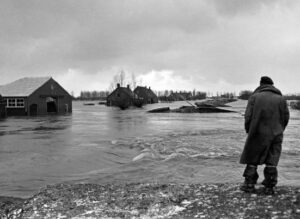
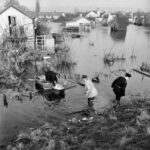 Warning sirens were put in place at the most at risk areas and are still in use today. The Dutch government quickly formed the Delta commission to study the floods and eventually commissioned the ‘Delta Works’ to enable the closing of estuaries to prevent upstream flooding and included dams, sluices, locks, dikes, levees, and barriers. Taxes were implemented and readily accepted with a national mind-set that this must never happen again. Even today, commemorations still happen on every anniversary for the dead.
Warning sirens were put in place at the most at risk areas and are still in use today. The Dutch government quickly formed the Delta commission to study the floods and eventually commissioned the ‘Delta Works’ to enable the closing of estuaries to prevent upstream flooding and included dams, sluices, locks, dikes, levees, and barriers. Taxes were implemented and readily accepted with a national mind-set that this must never happen again. Even today, commemorations still happen on every anniversary for the dead.

 My grand nephew, James Renville got the “travel bug” early on in his life. The first trip he took was when he was just when he was just 3 weeks old. His parents, my niece Toni Chase and her then husband, Jim Renville to their newborn son to meet his grandpa in North Dakota. Many babies don’t do well on long trips, but James was calm throughout the seven hour drive. He was such a good baby for them. The only times he fussed was when he was hungry, and then it wasn’t much fussing. Really, from that point on, James was at his most calm when he was traveling. His mom says that he “knew what vacation meant from the start.”
My grand nephew, James Renville got the “travel bug” early on in his life. The first trip he took was when he was just when he was just 3 weeks old. His parents, my niece Toni Chase and her then husband, Jim Renville to their newborn son to meet his grandpa in North Dakota. Many babies don’t do well on long trips, but James was calm throughout the seven hour drive. He was such a good baby for them. The only times he fussed was when he was hungry, and then it wasn’t much fussing. Really, from that point on, James was at his most calm when he was traveling. His mom says that he “knew what vacation meant from the start.”
Toni read somewhere, and many of us have always thought the same thing, that when you are an “only child,” like James is, that “you are likely to mature early and manifest adult behaviors an attitudes.” I’m sure it is because they around adults so much. That was never made more clear to her than when they went on the first trip that James was old enough to really know what was going on. They took James to the water park in South Dakota. He really had a blast, but he refused to go on any of the “kiddie slides” or “baby slides,” as he called them. While that was great for James, it meant that since James really was a “kiddie” or “baby” himself, he also couldn’t go on the big slides without an adult. So, his mom and dad had to go up and down the steep hills, carrying James most of the way, in the 90° heat to get to the slides. The plan had been to let the kids…James and his cousins…play for a while, and then head home in the afternoon. Well, when everyone else was ready to go…the cousins had already fallen asleep, James definitely was not. He wasn’t one bit tired, or as his mom puts it, “Not even a yawn!” They ended up staying until the park closed.
Last August, James took a trip with some friends of his. It was a chance to say goodbye to summer, and to one friend who was leaving to start his career in the Air Force. For James, it was also a way to “say goodbye” to 
 being a kid. College was over, and everything was going to be different now. The friends went to Denver to cut loose a little bit. They went to Eliches, went clubbing, and checked out some of the breweries. Toni began to think of what was coming next. She wanted things to be good for James, and he did love to travel. He had taken tips to the Netherlands and Spain, and she wanted to do something fun for him.
being a kid. College was over, and everything was going to be different now. The friends went to Denver to cut loose a little bit. They went to Eliches, went clubbing, and checked out some of the breweries. Toni began to think of what was coming next. She wanted things to be good for James, and he did love to travel. He had taken tips to the Netherlands and Spain, and she wanted to do something fun for him.
Toni and her husband, Dave Chase began to plan their own travels and some trips for James too. Things started off really well. Toni and Dave took him to a concert at Red Rocks in Denver. It was to be the first of several fun trips the family would take, including a trip to San Diego with Toni and Dave. The San Diego trip was amazing too. They spent 5 days there. They planned activities for every day. They went to an air show that Toni is sure James only went to “for her.” Then afterward, James said it wasn’t what he had expected. He said he had a great time. Then they went to a festival in La Jolla, several beaches on the ocean, the Cabrillo National Monument and the surrounding area, and the brewery district in the San Diego area…then relaxed at the resort.
After these trips, the Covid-19 Pandemic hit, and the whole world went into turmoil. For James that meant no trip to Las Vegas with his dad, Jim and the rest of their pool team for his first pool tournament, and trip that was to be the “Shangri La” of them all, James’ long awaited trip to the western coast of South America. He had planned to take that one last year, but couldn’t get the time off from his job. Now, it is all on hold, until the trips can be rearranged, and who knows how long that will be. Still, James really was born with the “traveling bug” and he has been building his skills for years. He is very driven and never wants to miss a thing. His past trips have included the Rocky Mountain Region (Wyoming, Montana, Utah, South Dakota, North Dakota, and 
 Colorado), the deserts of Nevada, the lakes of Arizona, the beaches of Florida, the ocean surrounding California, the eastern shores of Virginia and Washington DC, the costal plains of Alabama, the French Quarter of New Orleans nd Louisiana, the Ozark Mountains of Arkansas, and far beyond the northern hemisphere to see parts of the Netherlands and Spain. While some of his trips were cancelled or postponed this year, there is always next year. For James…well, next up is Peru, and it will be amazing!! Today is James’ birthday. Happy birthday James!! Have a great day!! We love you!!
Colorado), the deserts of Nevada, the lakes of Arizona, the beaches of Florida, the ocean surrounding California, the eastern shores of Virginia and Washington DC, the costal plains of Alabama, the French Quarter of New Orleans nd Louisiana, the Ozark Mountains of Arkansas, and far beyond the northern hemisphere to see parts of the Netherlands and Spain. While some of his trips were cancelled or postponed this year, there is always next year. For James…well, next up is Peru, and it will be amazing!! Today is James’ birthday. Happy birthday James!! Have a great day!! We love you!!
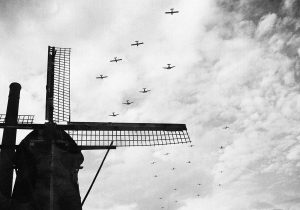 It has been 74 years since 17,740 Americans gave their lives to liberate the people of the Netherlands (often called Holland) from the Germans during World War II, and the people of Holland have never forgotten that sacrifice. For 74 years now, the people of the small village of Margraten, Netherlands have taken care of the graves of the lost at the Margraten American Cemetery. On Memorial Day, they come, every year, bringing Memorial Day bouquets for men and women they never knew, but whose 8,300 headstones the people of the Netherlands have adopted as their own. Of the 17,740 who were originally buried there, 9,440 were later moved to various paces in he United States by their families. “What would cause a nation recovering from losses and trauma of their own to adopt the sons and daughters of another nation?” asked Chotin, the only American descendant to speak on that Sunday 4 years ago. “And what would keep that commitment alive for all of these years, when the memory of that war has begun to fade? It is a unique occurrence in the history of civilization.”
It has been 74 years since 17,740 Americans gave their lives to liberate the people of the Netherlands (often called Holland) from the Germans during World War II, and the people of Holland have never forgotten that sacrifice. For 74 years now, the people of the small village of Margraten, Netherlands have taken care of the graves of the lost at the Margraten American Cemetery. On Memorial Day, they come, every year, bringing Memorial Day bouquets for men and women they never knew, but whose 8,300 headstones the people of the Netherlands have adopted as their own. Of the 17,740 who were originally buried there, 9,440 were later moved to various paces in he United States by their families. “What would cause a nation recovering from losses and trauma of their own to adopt the sons and daughters of another nation?” asked Chotin, the only American descendant to speak on that Sunday 4 years ago. “And what would keep that commitment alive for all of these years, when the memory of that war has begun to fade? It is a unique occurrence in the history of civilization.”
The people of Margraten immediately embraced the Americans, who had come to their aid when they needed it most. The town’s mayor invited the company’s commanders to sleep in his home, while the enlisted men slept in the schools. The protection against rain and buzz bombs was welcomed. Later, villagers hosted U.S. troops when the men were given rest-and-recuperation breaks from trying to breach the German frontier defenses, known as the Siegfried Line. “After four dark years of occupation, suddenly [the Dutch] people were free from the Nazis, and they could go back to their normal lives and enjoy all the freedoms they were used to. They knew they had to thank the American allies for that,” explained Frenk Lahaye, an associate at the cemetery.
By November 1944, two months after the village’s 1,500 residents had been freed from Nazi occupation by the U.S. 30th Infantry Division the town’s people were filled with gratitude, but the war wasn’t over. In late 1944 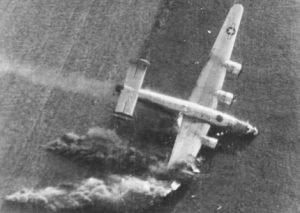 and early 1945, thousands of American soldiers would be killed in nearby battles trying to pierce the German defense lines. The area was filled with Booby-traps and heavy artillery fire. All that combined with a ferocious winter, dealt major setbacks to the Allies, who had already suffered losses trying to capture strategic Dutch bridges crossing into Germany during the ill-fated Operation Market Garden.
and early 1945, thousands of American soldiers would be killed in nearby battles trying to pierce the German defense lines. The area was filled with Booby-traps and heavy artillery fire. All that combined with a ferocious winter, dealt major setbacks to the Allies, who had already suffered losses trying to capture strategic Dutch bridges crossing into Germany during the ill-fated Operation Market Garden.
Now, the U.S. military needed a place to bury its fallen. The Americans ultimately picked a fruit orchard just outside Margraten. On the first day of digging, the sight of so many bodies made the men in the 611th Quartermaster Graves Registration Company ill. The bodies arrived in a procession of trucks and trailers. Death hung in the air over the whole village of Margraten. The sight of so much death caused a few of the people helping with the burials to become ill. They suddenly made a break for the latrines. The first burial at Margraten took place on November 10, 1944. Laid to rest in Plot A, Row 1, Grave 1: John David Singer Jr, a 25-year-old infantryman, whose remains would later be repatriated and buried in Denton, Maryland, about 72 miles east of Washington. Between late 1944 and spring 1945, up to 500 bodies arrived each day, so many that the mayor went door to door asking villagers for help with the digging. Over the next two years, about 17,740 American soldiers would be buried here, though the number of graves would shrink as thousands of families asked for their loved ones’ remains to be sent home, until 8,300 remained, and still, the graves are cared for by the town’s people, as if the dead were their own loved one. Not only that, but they have taken it upon themselves to research the deceased, and learn of their lives as a way of showing honor to these fallen heroes.
On May 29, 1945, the day before the cemetery’s first Memorial Day commemoration, 20 trucks from the 611th  collected flowers from 60 different Dutch villages. Nearly 200 Dutch men, women and children spent all night arranging flowers and wreaths by the dirt-covered graves, which bore makeshift wooden crosses and Stars of David. By 8am, the road leading into Margraten was jammed with Dutch people coming on foot, bicycle, carriages, horseback and by car. Silent film footage shot that day shows some of the men wearing top hats as they carried wreaths. A nun and two young girls laid flowers at a grave, then prayed. Solemn-faced children watched as cannons blasted salutes. The Dutch, Shomon wrote, “were perceptibly stirred, wept in bowed reverence.” All they do for these heroes is because they have vowed never to forget.
collected flowers from 60 different Dutch villages. Nearly 200 Dutch men, women and children spent all night arranging flowers and wreaths by the dirt-covered graves, which bore makeshift wooden crosses and Stars of David. By 8am, the road leading into Margraten was jammed with Dutch people coming on foot, bicycle, carriages, horseback and by car. Silent film footage shot that day shows some of the men wearing top hats as they carried wreaths. A nun and two young girls laid flowers at a grave, then prayed. Solemn-faced children watched as cannons blasted salutes. The Dutch, Shomon wrote, “were perceptibly stirred, wept in bowed reverence.” All they do for these heroes is because they have vowed never to forget.

 I know that lots of people have been in long distance relationships, but I don’t know of a lot of people, aside from soldiers and their families, who have been in one that is quite as distant as my grand nephew, James Renville, and his girlfriend, Julia Vergnes. James lives here in Casper, Wyoming, and met Julia while she was an exchange student at Kelly Walsh High School. They began dating in January of 2015, and their relationship has continued even though she is back home in Heemstede, North Holland, Netherlands, which is near the capital city of Amsterdam. I can’t imagine how hard it is for them to be so far apart, both of them going to college, trying to concentrate on their studies, and yet missing each other so much. The short visits they have had to each others homes must have seemed way too short a time, but it is what they have. Time will tell where their futures will take them from here. Time and distance can take their toll, or they can solidify a relationship. Time will tell.
I know that lots of people have been in long distance relationships, but I don’t know of a lot of people, aside from soldiers and their families, who have been in one that is quite as distant as my grand nephew, James Renville, and his girlfriend, Julia Vergnes. James lives here in Casper, Wyoming, and met Julia while she was an exchange student at Kelly Walsh High School. They began dating in January of 2015, and their relationship has continued even though she is back home in Heemstede, North Holland, Netherlands, which is near the capital city of Amsterdam. I can’t imagine how hard it is for them to be so far apart, both of them going to college, trying to concentrate on their studies, and yet missing each other so much. The short visits they have had to each others homes must have seemed way too short a time, but it is what they have. Time will tell where their futures will take them from here. Time and distance can take their toll, or they can solidify a relationship. Time will tell.
I never would have expected James to become a world traveler, but life takes us all in different directions. As he did last year, James will travel to Amsterdam in July to visit Julia. I think that it’s a very cool thing that he gets to make the trip. The Netherlands is a beautiful country, but I don’t know how much James cares about the scenery. Because he has been there with Julia, he has had the opportunity to make a lot of new friends there as well. I’m sure the adventure of traveling is a big draw for James too.
James is such a personable guy, and has a really kind heart. He has always been one person all the little kids 
 love to hang out with, or just hang on. He is a good older cousin, and he makes them feel important. That is what is important when it comes to little kids. Kids don’t like to always be treated…well, like little kids, and James gets that, so they like him. James hasn’t totally decided what he wants to do with his life yet, so at this point he is taking the reqired courses at college. Whatever he decides to do, I know he will be successful at it…no matter where his dreams take him. Today is James’ birthday. Happy birthday James!! Have a great day!! We love you!!
love to hang out with, or just hang on. He is a good older cousin, and he makes them feel important. That is what is important when it comes to little kids. Kids don’t like to always be treated…well, like little kids, and James gets that, so they like him. James hasn’t totally decided what he wants to do with his life yet, so at this point he is taking the reqired courses at college. Whatever he decides to do, I know he will be successful at it…no matter where his dreams take him. Today is James’ birthday. Happy birthday James!! Have a great day!! We love you!!

